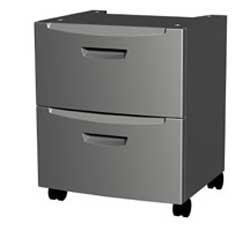Being able to custom configure your own laser system is yet another innovative philosophy that Highlight Technologies has adopted to service the needs of its customer base. We believe that the customer should purchase only what is needed. It is also important that owners of ULS systems have the confidence in knowing that they can easily expand the capabilities of their laser system(s) as their business needs expand
Jump to Section:
- Air Assist Filtration System for Oil-Less Compressors
- Backsweep Option
- Coaxial Air Assist with Optics Protection – Computer Controlled
- Coaxial Air Assist with Optics Protection – Non-Computer Controlled
- External Compressor for Air Assist
- VersaLaser Computer Controlled Air Cleaner / Cart
- Dual Head
- VersaLaser Focus Lens Kit
- Honeycomb Cutting Table
- HPDFO Lens
- Rotary
- VersaLaser Cart/Stand
Universal Laser Systems Accessories
Being able to custom configure your own laser system is yet another innovative philosophy that Highlight Technologies has adopted to service the needs of its customer base. We believe that the customer should purchase only what is needed. It is also important that owners of ULS systems have the confidence in knowing that they can easily expand the capabilities of their laser system(s) as their business needs expand
- Air Assist Filtration System for Oil-Less Compressors
- Backsweep Option
- Coaxial Air Assist with Optics Protection – Computer Controlled
- Coaxial Air Assist with Optics Protection – Non-Computer Controlled
- External Compressor for Air Assist
- VersaLaser Computer Controlled Air Cleaner / Cart
- Dual Head
- VersaLaser Focus Lens Kit
- Honeycomb Cutting Table
- HPDFO Lens
- Rotary
- VersaLaser Cart/Stand
Air Assist Filtration System for Oil-Less Compressors
This assembly has three stages of filtration and was designed for oil less air compressors. There is a stage for subtle background oil removal, moisture, and particulate. This system also has the necessary fittings to go from your air compressor directly to the laser system. Using this system will prevent hours of downtime and minimize the potential of damaging your optics.
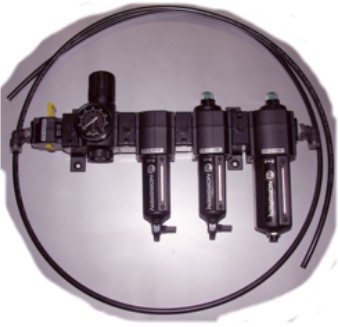
Backsweep Option
The back-sweep option blows an air jet toward the back of the machine, and the angle and height of the air jet can be independently adjusted. A flexible air tube is attached to an air outlet arm that can be rotated and locked in position to set the angle. The arm is attached to a bracket that can be adjusted up or down to match the focus point.
As we would expect from ULS engineering, this option has been well designed for precision, ease of use, and effectiveness! Combining this option with a nozzle cone and adjustable pressure lets the customer use air to the best advantage according to the type of application.
Choice of Output and Print Driver:
The XP/2000 print driver has an option for front-to-back engraving.
Front-to-back engraving with the back-sweep works well on rubber stamps or other dusty applications. It helps keep the material clean and also keeps the machine cleaner.
For cutting applications the nozzle is superior. The nozzle is also superior for heavy engraving on highly flammable materials because the downward air jet protects the focus lens from flame damage.
Purpose:
To blow high pressure air at the point of laser interaction with the material to be cut or engraved.
Advantage:
High pressure design with user-adjustable pressure regulator can be configured for many applications. Back sweep design reduces flaming and cools material as well as directs smoke and fumes toward the exhaust, thus keeping engraving and cutting materials cleaner.
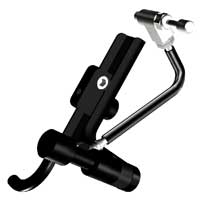
Coaxial Air Assist with Optics Protection - Computer Controlled
Coaxial Air Assist with Optics Protection:
Computer Controlled, suppresses flaming and assists with optics protection.
Advantage:
The Computer Controlled Air Assist is controlled by the print driver and allows up to two air sources or one air and one gas source. One air source is used to protect the moving mirrors and lens. The same air source or another source of air or gas can be forced directly in line with the laser path through a nozzle below the lens to assist in engraving or cutting. Air or gas can be turned on to high or low pressure or off during the job, all controlled by commands from the computer. Directing air onto the optics instead of using gas saves the expense of gas. The computer control only turns on the gas flow when necessary saving the expense of gas that would be wasted in a simple on/off system. Computer control also shuts off the ULS compressor pump when it is not needed.
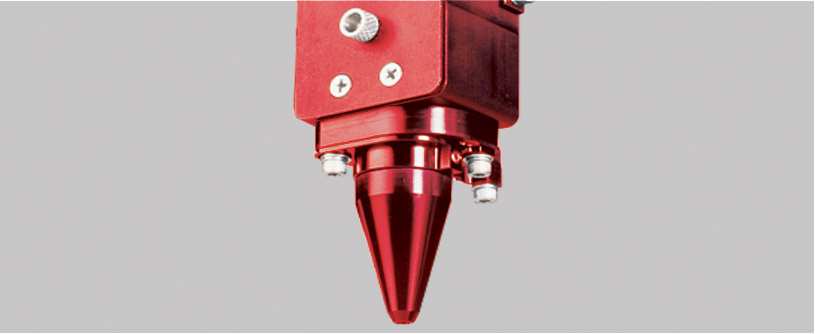
Coaxial Air Assist with Optics Protection - Non-Computer Controlled
Coaxial Air Assist with Optics Protection:
Computer Controlled, suppresses flaming and assists with optics protection.
The Non-Computer Controlled Air Assist provides the same lens and mirror protection and flame suppression (using a nozzle) as the more sophisticated Computer Controlled Air Assist but with a single gas and no computer control. Turning the compressor pump or gas supply on lets air or gas flow. Turning the compressor pump or gas supply off stops the air or gas flow.

External Compressor for Air Assist
The External Compressor for Air Assist provides the air source for Air Assist.
Advantage:
Though other air sources can be used, the External Compressor was designed to provide the appropriate air supply from a compact, reasonably quiet and easy to use package. The unit consists of an oil-free compressor, desiccant drying cartridge, an in-line filter and all required hoses, fittings and connections.
Compatibility:
All platforms with Air Assist.
Installation:
Quick connector connection to the machine and standard electrical hookups.
Common Uses:
Recommended as an air source for the Air Assist.
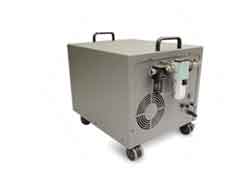
VersaLaser Computer Controlled Air Cleaner / Cart
The same design and function as the Integrated Cart except storage space is replaced by built in air cleaner.
- Controlled through a USB port and activated only when jobs are in process
- Air cleaner is concealed behind drawers (no storage)
- Air filtration eliminates smoke and dust
Size: 25″ W x 26″ D x 30″ H
(625mm x 660mm x 762mm)
Weight: 95 pounds (43.2 Kg) without filters (shipped with one set of filters); 170 pounds (77.3 Kg) with filters installed
Recommended for installations where venting to the outside is not convenient or possible
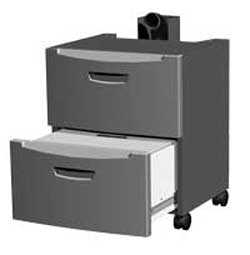
Dual Head
The Dual Head Option allows laser processing of two identical jobs at the same time. It does this by splitting the work area into two identical work areas and the beam into two beams. Because splitting the beam reduces each beams power by approximately 50%, it is usually necessary to reduce processing speed.
Advantage:
Production rate increases from 0-100% depending on application. Advantages typically increase with higher power and larger engraving areas.
Compatibility:
Professional Series (M-360, X & V platforms)
Installation:
Under one minute.
Common Uses:
High volume production of large identical items.
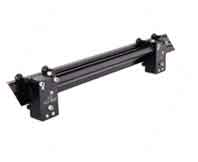
VersaLaser Focus Lens Kit
The different Focus Lens Options allow the user more flexibility with special applications.
Advantage: For most CO2 applications, the standard or universal 2.0″ focal length lens is the best choice. For very specialized applications, lenses are available with either a smaller spot size or are longer to give more clearance between the lens and the work. Other sizes include 1.5″.
Compatibility: All laser platforms. The lens and the third mirror are mounted on a quick install holder assembly.
Installations: Less than ten seconds with no tools required.
Common Uses: To give more clearance or reduce beam spot size for very special applications. Smaller rubber stamps can have finer detail with the 1.5″ lens. And a 4″ lens would be more suitable engraving the bottom of a bowl that requires more clearance from the lens assembly to avoid hitting the side of the bowl.
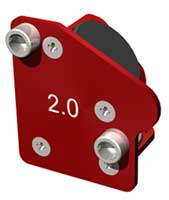
Honeycomb Cutting Table
The Honeycomb Cutting Table supports materials being laser cut and provides some vacuum hold down.
Advantage:
Minimizes burning of the back side of materials being cut all the way through by supporting materials above the reflective work table in the machine. The honeycomb design supports even small cut parts.
The cutting table is designed to draw air through it to remove smoke and cutting vapors as they are generated which aids in keeping the cut parts and the machine cleaner. The table has ruler guides similar to the work table it is installed onto to aid in positioning materials.
The unit can be removed for easy cleaning.
Compatibility:
All M, V and X laser platforms.
Common Uses:
Acrylic, wood, and paper cutting.
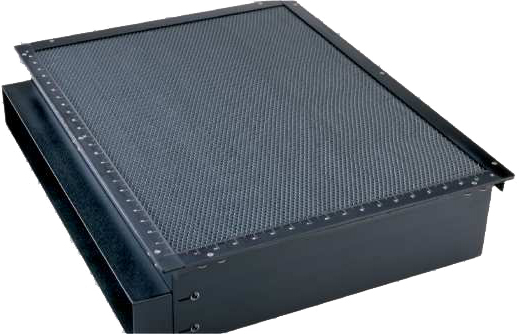
HPDFO Lens
As the demand for finer detailed engraving and cutting increases, Universal Laser Systems has developed the High Power Density Focusing Optics (HPDFO) option.
It produces a smaller, focused laser beam “spot” than a standard laser beam delivery, optical system. Depending on the type of material being processed, and the desired effect, the effective spot size produced by this option can be as small as 1/4th the size of the spot produced by a standard 2.0 inch focusing lens.
How Does It Work:
The HPDFO consists of two parts, the Beam Expander assembly, which is mounted in place of the Beam Window, and the High-Resolution Optics assembly, which replaces the Focus Lens assembly. Through specialized optics, the HPDFO expands the diameter of the laser beam and concentrates that expanded energy at the focus point to produce a smaller focused spot that has a much higher power density.
Applications:
With a smaller spot size (higher power density), and depending on your application material, you can engrave smaller text, produce higher resolution graphics and photographs, vector mark and cut thinner lines, and cut deeper with the same laser power. It is even possible to scribe and/or etch some uncoated metals, such as stainless steel, directly without the assistance of chemicals or coatings.
HPDFO Optics achieves dramatically improved resolution for applications requiring extremely fine detail (small font sizes) or photos.
Compatibility:
M, V, X and XL Series laser systems; field retrofit kits are available for older machines.

Rotary
The Rotary Fixture allows spherical, conical and cylindrical objects to be marked, cut and engraved.
Benefits:
- Accepts non-symmetrical objects
- Maintains precision accuracy
- Maintains repeatability
- Taper compensation
- 360 degree processing
- Allows raster and vector processing
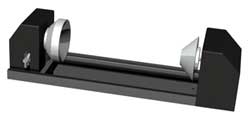
VersaLaser Cart/Stand
The sleek design blends the cart with a VersaLaser™ for a stylish floor standing unit.
- Maximum stability at low cost
- Durable construction for many years of dependable service
- Locking casters for moving convenience
- Two large storage drawers
- Top indents “lock” VersaLaser™ unit in place
Size:
25″ W x 22″ D x 30″ H (625mm x 559mm x 762mm)
Weight:
70 pounds (31.8 Kg)
